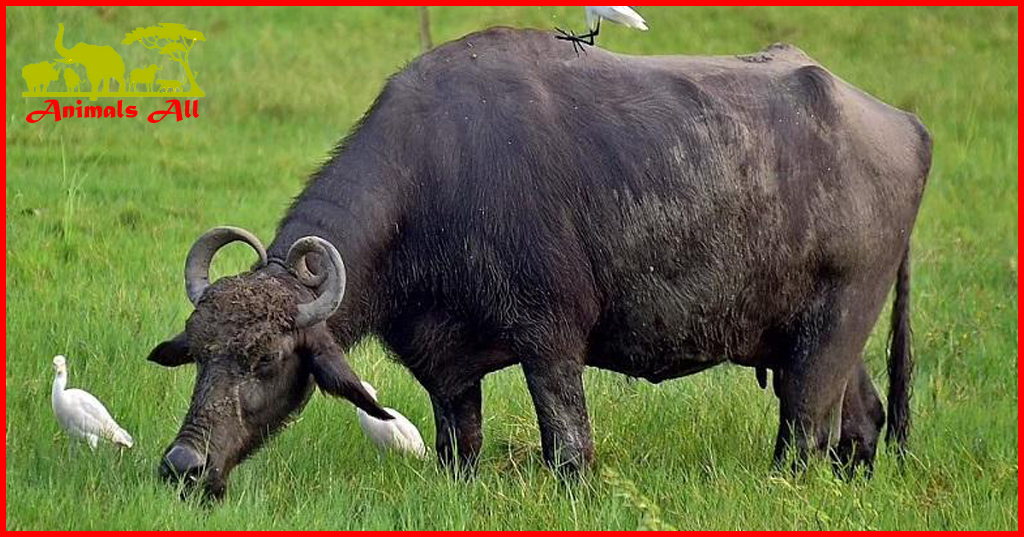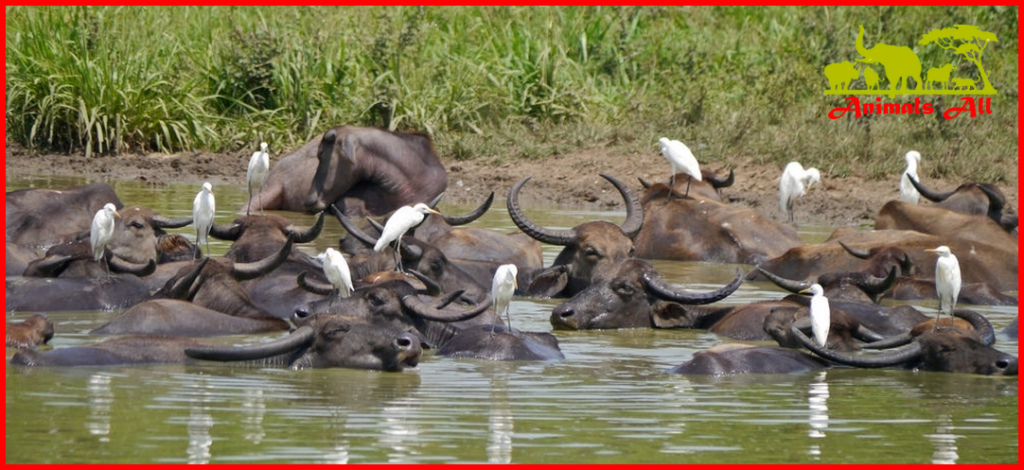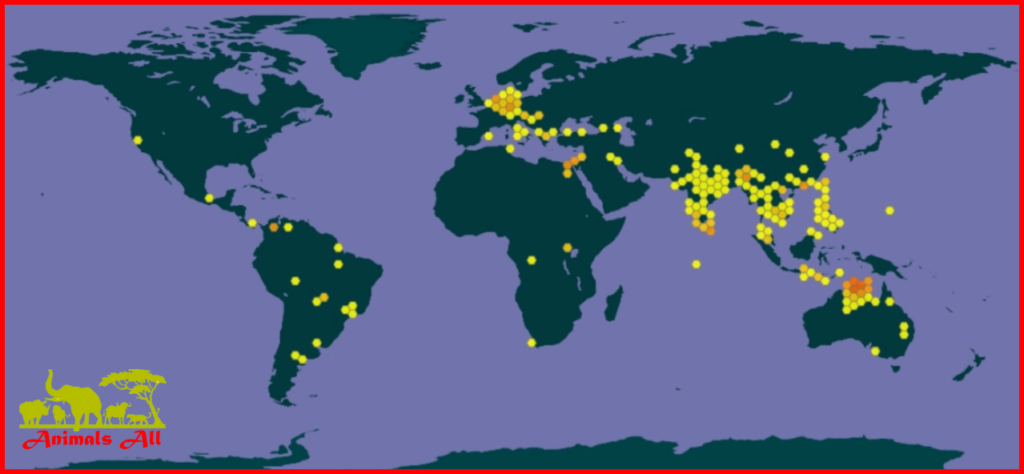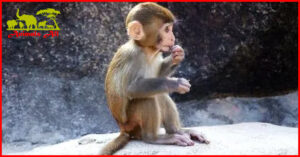
Buffalo, A useful animal in the world
Buffalo is a mammal of the genus Buffalo in the family Bovidae. The body is obese. The head is large; both males and females have a pair of horns on their heads, which are long and slightly flat, curved, with many joints on the upper part. The forehead is broad, the mouth is large, and there are two large nostrils above the upper lip, with hard and smooth skin between them and no hair.
The nose is wide; the eyes and ears are large; the neck is short; the waist and abdomen are bulging, and the limbs are relatively short; the hooves are large; the skin is thick and has no sweat glands, and the hair is coarse and short, which is denser in the front of the body and sparser on the back, chest and abdomen. The body color is mostly gray-black, but there are also yellow-brown or white. It is named after its water-loving nature. The lifespan can reach 20-30 years.
Buffaloes are mainly distributed in tropical and subtropical regions, with most of them distributed in Asia, Africa, Latin America, Oceania and some countries in southeastern Europe. Chinese water buffalo are mainly distributed in the southern region. Wild species live in jungles, bamboo forests, or reed beds. Herbivorous livestock, Likes to eat grass, etc. When feeding, it is important to note that the animals are weaker in spring, so it is important to pay attention to the combination of forage and to supplement their feed with concentrated feed every day. In winter, it is important to prevent frost and colds. Reproduction has a distinct seasonality. The duration of estrus is longer. The gestation period is generally twelve months.
History of Zoology
Buffaloes have thick skin and underdeveloped sweat glands. When they are hot, they need to soak in water to dissipate heat. They often soak in water, hence the name buffalo. They have short legs and large hooves, which are suitable for farming. Their work force, milk production and tolerance to roughness are higher than those of cattle . Buffaloes milk fat content is about 8%, and the fat is white. Their meat is coarse. Because of their high utilization value, they have been domesticated by humans for a long time.
Domestic buffaloes were domesticated from wild buffaloes, and may have a history of about 5,000 years. Asian buffaloes were domesticate around 4000 BC. Many Asian countries use them as working animals . The earliest domesticated cattle known to China are the remains of buffaloes found at the Hemudu and Luojiajiao sites 6,000 to 7,000 years ago.
In Europe, they are use as dairy cows or cattle for food in Italy, Romania, and Bulgaria. In Asia, water buffalo are used primarily as laborers; they are still found wild in India, Nepal, Bhutan, and Thailand, and in northern Australia. The origins of wild water buffalo in Southeast Asia are unclear; they may be descendants of domesticated buffalo that have returned to the wild, descendants of wild buffalo that were already in the area, or a cross between the two.

Farmin purpose
In China’s five thousand years of agricultural civilization, water buffaloes have always played the main role of providing power for farming (rice field plowing and transportation) So, the domestication of water buffaloes has a certain trajectory. Domesticated water buffaloes around the world are divided into swamp buffaloes ( Bubalus bubalis carabanesis ) (2n=48) and river buffaloes ( Bubalus bubalis bubalis ) (2n=50), mainly distributed in Asia. Swamp buffaloes are docile and have strong endurance, and are the main labor force for traditional agricultural rice farming; river buffaloes are large in size and produce high milk yields, and are mainly used as high-quality animal proteins such as beef cattle and milk.
The Asian buffaloes are divide into swamp buffaloes to the east and river buffaloes to the west, with the Bengal River as the line. There are about 40 million swamp buffaloes, mainly distributed in southern China and Southeast Asian countries such as Vietnam, Myanmar and Indonesia; there are about 160 million river buffaloes, mainly distributed in countries such as India and Pakistan.

Morphological characteristics
Buffalo is a large animal. The body length is 240-300 cm, the shoulder height is 150-180 cm, and the tail length is 60-100 cm. Wild male buffaloes weigh up to 1,200 kg, and females can weigh up to 800 kg; domestic buffaloes range from 250-550 kg. Males are slightly larger. They have a stout body, thick skin, and extremely underdeveloped sweat glands. When it is hot, they need to soak in water to dissipate heat. So they are called buffaloes; their horns are relatively slender. The auricle is relatively short and shaped like a large trumpet; the forehead is narrow and long. They are not like African wild buffaloes , whose horns grow almost in front of the forehead; the bases of buffalo horns are far apart. Both sexes have horns, but females are smaller than males.
Buffalo horns grow on bones, are hollow and have medulla, are thick and flat, and bend backwards in an arc shape. The root is slightly triangular and hollow, with many parallel concave lines on one side, and the horn tip is sharp; the color is dark brown, the texture is hard, and the cross-section lines are fine and not obvious. The hooves are large, firm, and resistant to soaking, with flexible stifle and fetlock joints, and the hair on the midline of the back facing forward, with the back sloping downward and backward.
Buffalo body
The buffalo has a sparse coat of hair that is mostly grey to grey-black; its tail is relatively long and bushy at the tip. The legs are usually half-shaved white to the knees. Adults are almost hairless, and the colour of their skin varies with climatic conditions, so it is sometimes difficult to determine their skin colour. The animals are usually cover in mud, and when dry, their skin is dark grey; however, when wet, it is usually dark brown to black. Many domesticated species of buffalo are greyer in colour and have drooping necks. The horns of the river buffalo (another domesticated species) are darker and tightly curled.
Habitat
The habitat is a sporadic mix of tall grasses, rivers and streams, and trees and forests. Such an environment provides ample water for drinking and sinking rocks with abundant food and dense cover. Generally speaking, buffalo are found at lower altitudes, but in Nepal, swamp buffalo are commonly found at altitudes of 2,800 meters. Domestication of the animal is common, and thus can be found in a wide variety of habitats. Most domesticated buffalo are found in agricultural communities, but can also be found in many cities.
Living habits
Buffaloes are diurnal animals. They are more sensitive to heat than most cattle because they have fewer sweat glands. As a result, buffaloes are know for wallowing in the mud. Wallowing in the mud helps to lower body temperature because the water in the mud evaporates more slowly, thus prolonging the cooling time. Buffaloes often graze in the morning and evening. During the hotter part of the day, they rest in dense cover or in the shade of trees, wallow in mud pits, or completely immerse themselves in water with only their nostrils and eyes exposed.
They like to wallow in the mud to dissipate heat and prevent insect bites. Buffaloes have keen senses and a well-developed sense of smell. Which some people believe played an important role in the domestication process. They have thick skin and short and sparse hair. They have underdeveloped sweat glands , about 1/6 of that of yellow cattle, so they have poor heat regulation function. Buffaloes like water and often soak and wallow in ponds to dissipate heat. Buffaloes are stout in appearance, and large individuals can even weigh up to 1 ton. They are gentle and easy to manage.
They are ruminants that feed primarily on grasses. Buffaloes also eat herbs, aquatic plants, leaves, crops, and various other plants that grow in rivers and streams.
Distribution area
Origin: Bhutan, Cambodia, India, Myanmar, Nepal, Thailand, Vietnam, Bangladesh, Indonesia, Laos and Sri Lanka.
The river buffalo (a domesticated species) inhabits Indochina, the Mediterranean, and parts of South and Central America. The swamp buffalo (another domesticated species) has an easterly distribution and inhabits Indochina, Southeast Asia, and Australia

Reproduction method
Mating is usually polygamous. The matrilineal group lives in a large, loosely knit group year-round. During the rainy season, adult males (in bachelor or solitary groups) enter the female group and mate with receptive females in estrus for 11-72 hours, but do not control them. After mating, the males are drive away. Generally, male cattle display dominance through posture and movement, and few conflicts escalate to the point of serious injury. Bulls determine estrus by sniffing the urine and genitals of cattle.
The timing of reproduction for this species is uncertain. In some areas, reproduction is seasonal, while in other areas it is independent of seasonality. Some areas that are dependent on seasonality, reproduction usually occurs after the rainy season, with calves born the following year close to the beginning of the rainy season. In areas with uncertain seasons, calves can be born year-round.
The estrus cycle is 21 days. Among female cattle, buffaloes have the longest gestation period, 300-340 days. Females usually give birth to one calf, but may also give birth to twins. Females give birth to one calf every two years on average. The calf weighs 35-40 kg at birth and is reddish brown to yellowish brown in color. The lactation period lasts 6 to 9 months.
Females reach sexual maturity at about 1.5 years of age and remain in maternal groups within larger groups. Males reach sexual maturity at the age of 3 years. At which point they leave the female group and often join bachelor groups.
Main varieties
The domestic water buffalo ( Bubalus bubalis ) is a descendant of the wild water buffalo ( Bubalus arnee ). Water buffalo have been kept primarily in Asia for thousands of years for human use. Their main use is as livestock and for the production of milk and meat. They can be divided into two types, riverine and swampy .

